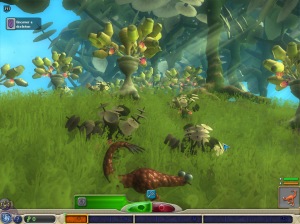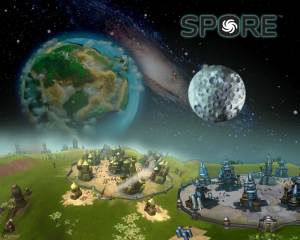Spore (PC) – Review
September 28, 2008
Probably the most hyped game in the past few months (definitely since GTA4 and MGS4), Spore is Will Wright’s and EA’s newest Sims-like game with added components of an RTS (real-time strategy). The object of the game is to take a creature from a microscopic stage (I’d say single-cell, but I’m not sure) of life all the way through galactic conquest via evolutionary add-ons, trade and warfare. How’s that for an elevator pitch?
Good: The game is an immersive world with a gradual learning curve. I believe this is something the whole family can enjoy for small snippets of time, but then again, I don’t have kids. Do I have any parents reading? What do you think?
The Creature Creator (sold seperately for those who want to populate their world with their own creations) is both a blessing and a curse. The blessing is the ability to fully customize the positions of arms, legs, necks, tails, spinal curvature , spikes, poison jets, skin color and texture, etc. The curse: for anyone with any level of OCD, get ready to spend a lot of time color coordinating arms and legs, swelling the belly and tapering the tails – and when you’re finally done with the creature, you’ll be too mentally fatigued to play the game that day.
Another beautiful aspect of the game that other studios should pay attention to is the level pacing. There are five different stages, or levels, to Spore: Cellular, Creature, Tribal, Civilization and Space (or Kick in the Nards). I found that when I began to tire of swallowing bits of cellular debris and adding spikes to my sides, it was time to move to the next stage. Also, by the time I made it to space, I was worried the game was almost over, only to find around 40% of the game’s content is in the final stage. Just say no to final stage Boss Battles and yes to long, immersive, final levels allowing you to use everything you’ve learned throughout the game!
The bad: Repetition. Once you make it to space, it’s all about repeating the terraforming and colonization of other planets and returning home to defend your planets. When you pan out to see the galactic view, you realize how long a journey you have to make it to the center and how many of these planets you have to colonize…and then you yawn. So, long final level? Check. Immersive? BONK!
Also, if you’re truly talking about an evolving species, the creature should have to carry on the traits of his ancestors, not suddenly switch from being a carnivore to an herbivore or removing all spikes and adding dancing feet. It’s fun, but doesn’t this destroy the idea of evolution?
Interactive Media
September 21, 2008
Since the AGDC, a thought has been nagging me in the back of my brain-bone. I want to open this up to discussion because I want to get a feel for what others think about the idea of interactive media. A great number of theories about the future of storytelling have popped up in conversations and so I turn to you.
What are the boundaries of interactive media and what is at its core?
I feel, at its core, a book is a form of interactive media, albeit rudimentary. A reader must turn the page to progress the storyline. This said, the author has complete control of where the story goes and the “player” merely turns the page and reads on. Linear? Yes. Interactive? Sure.
The problem seems to arise when folks begin discussing non-linearity and interactivity. Terms like “open world” and “sandbox” get tossed about and there is finger-pointing with shouts of, “That’s still linear!” Some seem to think the idea of storytelling is a burden to be placed on the shoulders of the gamer in the future.
WHAT?! Wait, why exactly should this happen?
The general theory appears as such: in our day-to-day lives, we constantly fill in blanks with things we see and conversations we overhear. Sometimes, we are spot-on. Other times, we create stories that are far greater than the actual occurrences. To this, I say, “Kudos! We all have some level of imagination and contextual reality.” But does this make us all good storytellers?
I fully understand the desire to interact with a game’s storyline and make it my own personal experience. As a fan of RPGs, it’s what I thrive on. But what makes a game a game? Furthermore, what makes an interesting storyline? Non-linearity is great, if done well. I love being able to do what I want (in any order) and having the consequences of my actions affect the outcome of the game. This being said, I want to be part of a strong story, not something being generated on the fly that has a greater than 50% chance of being worthless and uninteresting. As a writer, I have a daily opportunity to write garbage. As a gamer, I want a refined and polished storyline that can be altered – sometimes subtly, sometimes majorly – but never breaks my immersion.
In my opinion, you should enjoy a storyline that allows you to play along; a storyline that a professional has spent time on to make sure there are moments of tension and action, betrayal and emotional pulls. If you want full control of your destiny, play 2nd Life. Better yet, go to work.
Agree? Disagree? Let me here from you.
Austin Game Developers Conference – Review
September 19, 2008
From new friends to slammin’ parties and everything in between, the AGDC was everything I hoped it would be. Maybe more. I will try to be brief but invite all of you to ask any specific questions you may have about the goings-on of the conference.
Sunday night: The writers gang met at the Gingerman around 8:00pm and I met who would turn out to be the usual suspects: Jeff Spock, Rhianna Pratchett, Andy Walsh, Ron Toland, Susan O’Connor*, Haris Orkin, Richard Dansky, Tom Abernathy and others (sorry to any I may have left off…there was alcohol involved). Without missing a beat, Andy launched himself into several rants that were informative and entertaining all at once; not a bad skill for someone who would later be giving a lecture about OnDemand Dialogue.
*Meeting Susan will be forever memorable as I made a giant fool of myself by asking her husband if Susan was married. As a writer, this was a moment of poor word choice.
Monday:I arrived early to the convention center and brought two dozen donuts along with sign-up sheets, coupons and an easel. Registration was quick and painless and I got a shirt, a schwag bag and a water bottle. I met Kristy Bowden who brought boxes full of literature and books for our table. I set everything up with some help from Ron and things looked good!
I spent the day going to a few panels (including a brilliant session with Shana Merlin on improv storytelling and a critic-al workshop hosted by Richard Dansky) and manning the booth. I met Tim Langdell and we had a couple of drinks before leaving the center and making our way to the ArtHouse for music, art and drinks. There, Tim and I met with John Canning and left to eat dinner at Thai Passion. After this, the three of us went to the Sky Lounge for the Heatwave Interactive party. Open bar, food, cookies and Rock Band 2 competition – ‘Nuff said.
Tuesday: Waking up was a little difficult on Tuesday, but I still managed to arrive early with some donuts and kolaches. Interestingly, the booth, books, literature, poster and drapes were all gone! Mix up with CMP, but things got fixed while I attended Andy’s panel on the Prince of Persia and OnDemand Dialogue. Kudos to Andy on what seems like a very interesting way of handling story through dialogue in an open world. I had a chance to walk the Expo floor (pretty small and packed) and later attended the Writers’ SIG meeting to put many more faces withnames. The night was devoted to Valve’s party (I met Marc Laidlaw – the man behind the story behind the game of Half-Life) and the Gingerman.
Wednesday: The last day was slow for the first half, perhaps because Andy had left us. I manned the booth and then went to lunch (leaving the booth in the very able hands of Jeff Spock). Upon returning, I attended Adrian Hon’s panel of We Tell Stories and finished with an excellent presentation (or conversation speech) by Ground Zero Productions’ Flint Dille covering the necessary practices of writers wanting to break into the industry. A group of the writers ate at P.F. Chang’s and then split to attend different parties (most heading straight to the Gingerman).
I was sad to say goodbye to so many of the writers and even though I’ve already read emails from a few, I hope to see them again before next AGDC. Call me a pushover, but the 3 days and 4 nights of the conference have made me feel that a lot of the writers are more than just names on an email list now. They feel more like friends.
Again, if you have any specific questions about the conference (I know I was pretty vague here), please ask. I’d be more than happy to talk about this some more! Also, join the IGDA Writers’ SIG email list!






